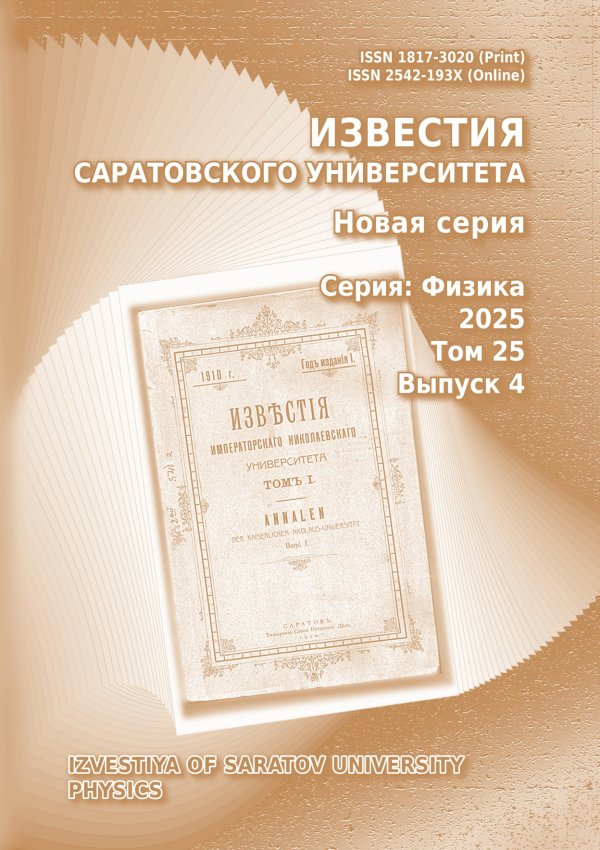Аппаратно-программный комплекс для диагностики психофизиологического состояния человека в процессе решения когнитивных задач
- Авторы: Курбако А.В.1, Храмков А.Н.1, Боровкова Е.И.1, Дубинкина Е.С.1, Ишбулатов Ю.М.1,2, Пономаренко В.И.2, Караваев А.С.1, Прохоров М.Д.2
-
Учреждения:
- Саратовский национальный исследовательский государственный университет имени Н. Г. Чернышевского
- Саратовский филиал Института радиотехники и электроники имени В. А. Котельникова РАН
- Выпуск: Том 24, № 1 (2024)
- Страницы: 19-29
- Раздел: Биофизика и медицинская физика
- URL: https://journals.rcsi.science/1817-3020/article/view/265328
- DOI: https://doi.org/10.18500/1817-3020-2024-24-1-19-29
- EDN: https://elibrary.ru/UFAMDM
- ID: 265328
Цитировать
Полный текст
Аннотация
Об авторах
Александр Васильевич Курбако
Саратовский национальный исследовательский государственный университет имени Н. Г. Чернышевского
ORCID iD: 0000-0002-3479-4609
410012, Россия, г. Саратов, ул. Астраханская, 83
Алексей Николаевич Храмков
Саратовский национальный исследовательский государственный университет имени Н. Г. Чернышевского
ORCID iD: 0000-0002-0730-6024
410012, Россия, г. Саратов, ул. Астраханская, 83
Екатерина Игоревна Боровкова
Саратовский национальный исследовательский государственный университет имени Н. Г. Чернышевского
ORCID iD: 0000-0003-1429-3599
410012, Россия, г. Саратов, ул. Астраханская, 83
Елизавета Сергеевна Дубинкина
Саратовский национальный исследовательский государственный университет имени Н. Г. Чернышевского
ORCID iD: 0000-0002-4636-3937
Scopus Author ID: 57221914404
ResearcherId: AGX-2150-2022
410012, Россия, г. Саратов, ул. Астраханская, 83
Юрий Михайлович Ишбулатов
Саратовский национальный исследовательский государственный университет имени Н. Г. Чернышевского; Саратовский филиал Института радиотехники и электроники имени В. А. Котельникова РАН
ORCID iD: 0000-0003-2871-5465
410012, Россия, г. Саратов, ул. Астраханская, 83
Владимир Иванович Пономаренко
Саратовский филиал Института радиотехники и электроники имени В. А. Котельникова РАН
ORCID iD: 0000-0002-1579-6465
Scopus Author ID: 35613865300
ResearcherId: H-2602-2012
410019 Саратов, ул. Зеленая, д. 38
Анатолий Сергеевич Караваев
Саратовский национальный исследовательский государственный университет имени Н. Г. Чернышевского
ORCID iD: 0000-0003-4678-3648
410012, Россия, г. Саратов, ул. Астраханская, 83
Михаил Дмитриевич Прохоров
Саратовский филиал Института радиотехники и электроники имени В. А. Котельникова РАН
ORCID iD: 0000-0003-4069-9410
Scopus Author ID: 7003520378
ResearcherId: D-6659-2013
410019 Саратов, ул. Зеленая, д. 38
Список литературы
- Ильин Е. П. Теория функциональных систем в физиологии и психологии. М. : Наука, 1978. 383 с.
- Левитов Н. Д. О психических состояниях человека. М. : Просвещение, 1964. 360 с.
- Hebb D. O. Drives and the C. N. S. (conceptual nervous system) // Psychological Review. 1955. Vol. 62, iss. 4. P. 243–254. https://doi.org/10.1037/h0041823
- Giannakakis G., Grigoriadis D., Giannakaki K., Simantiraki O., Roniotis A., Tsiknakis M. Review on psychological stress detection using biosignals // IEEE Transactions on Affective Computing. 2022. Vol. 13, iss. 1. P. 440–460. https://doi.org/10.1109/TAFFС.2019.2927337
- Kirschbaum C., Hellhammer D. H. Salivary cortisol in psychoneuroendocrine research: recent developments and applications // Psychoneuroendocrinology. 1994. Vol. 19, iss. 4. P. 313–333. https://doi.org/10.1016/0306-4530(94)90013-2
- Hanrahan K., McCarthy A. M., Kleiber C., Lutgendorf S., Tsalikian E. Strategies for salivary cortisol collection and analysis in research with children // Appl. Nurs. Res. 2006. Vol. 19, iss. 2. P. 95–101. https://doi.org/10.1016/j.apnr.2006.02.001
- Engert V., Vogel S., Efanov S. I., Duchesne A., Corbo V., Ali N., Pruessner J. C. Investigation into the cross-correlation of salivary cortisol and alpha-amylase responses to psychological stress // Psychoneuroendocrinology. 2011. Vol. 36, iss. 9. P. 1294–1302. https://doi.org/10.1016/j.psyneuen.2011.02.018
- Puterman E., O’Donovan A., Adler N. E., Tomiyama A. J., Kemeny M., Wolkowitz O. M., Epel E. Physical activity moderates effects of stressor-induced rumination on cortisol reactivity // Psychosom. Med. 2011. Vol. 73, iss. 7. P. 604–611. https://doi.org/10.1097/PSY.0b013e318229e1e0
- Al-shargie F. M., Tang T. B., Babruddin N., Kiguchi M. Mental stress quantification using EEG signals // International Conference for Innovation in Biomedical Engineering and Life Sciences. 2016. Vol. 56. P. 15–19.
- Schleifer L. M., Spalding T. W., Kerick S. E., Cram J. R., Ley R., Hatfield B. D. Mental stress and trapezius muscle activation under psychomotor challenge: A focus on EMG gaps during computer work // Psychophysiology. 2008. Vol. 45, iss. 3. P. 356–365. https://doi.org/10.1111/j.1469-8986.2008.00645.x
- Dikecligil G. N., Mujica-Parodi L. R. Ambulatory and challenge-associated heart rate variability measures predict cardiac responses to real-world acute emotional stress // Biol. Psychiatry. 2010. Vol. 67, iss. 12. P. 1185–1190. https://doi.org/10.1016/j.biopsych.2010.02.001
- Carroll D., Phillips A. C., Der G., Hunt K., Benzeval M. Blood pressure reactions to acute mental stress and future blood pressure status: Data from the 12-year follow-up of the West of Scotland Study // Psychosom. Med. 2011. Vol. 73, iss. 9. P. 737–742. https://doi.org/10.1097/PSY.0b013e3182359808
- Setz C., Arnrich B., Schumm J., La Marca R., Tröster G., Ehlert U. Discriminating Stress From Cognitive Load Using a Wearable EDA Device // Transactions on Information Technology in Biomedicine. 2010. Vol. 14, iss. 2. P. 410–417. https://doi.org/10.1109/TITB.2009.2036164
- Prokhorov M. D., Borovkova E. I., Hramkov A. N., Dubinkina E. S., Ponomarenko V. I., Ishbulatov Y. M., Kurbako A. V., Karavaev A. S. Changes in the Power and Coupling of Infra-Slow Oscillations in the Signals of EEG Leads during Stress-Inducing Cognitive Tasks // Appl. Sci. 2023. Vol. 13, iss. 14. Article number 8390. https://doi.org/10.3390/app13148390
- Borovkova E. I., Hramkov A. N., Dubinkina E. S., Ponomarenko V. I., Bezruchko B. P., Ishbulatov Yu. M., Kurbako A. V., Karavaev A. S., Prokhorov M. D. Biomarkers of the psychophysiological state during the cognitive tasks estimated from the signals of the brain, cardiovascular and respiratory systems // Eur. Phys. J. 2023. Spec. Top. 232. P. 625–633. https://doi.org/10.1140/epjs/s11734-022-00734-z
- Everly G. S., Lating J. M. The Anatomy and Physiology of the Human Stress Response // A Clinical Guide to the Treatment of the Human Stress Response. Springer, 2013. P. 17–51.
- Aladjalova N. A. Infra-Slow Rhythmic Oscillations of The Steady Potential of the Cerebral Cortex // Nature. 1957. Vol. 179. P. 957–959. https://doi.org/10.1038/179957a0
- Галимов Н. М., Вильданов Э. Р., Хидиятов И. И., Кальметьев А. Х., Султанов А. Ф., Валиуллин Р. Ч. Сверхмедленные физиологические процессы головного мозга человека и животных в экспериментальных клинических исследованиях // Медицинский вестник Башкортостана. 2009. Т. 4, вып. 3. С. 63–69.
- Lorincz M. L., Geall F., Bao Y., Crunelli V., Hughes S. W. ATP-Dependent Infra-Slow (
- Knyazev G. G. EEG delta oscillations as a correlate of basic homeostatic and motivational processes // Neuroscience and Biobehavioral Reviews. 2012. Vol. 36, iss. 1. P. 677–695. https://doi.org/10.1016/j.neubiorev.2011.10.002
- Lambertz M., Langhorst P. Simultaneous changes of rhythmic organization in brainstem neurons, respiration, cardiovascular system and EEG between 0.05 Hz and 0.5 Hz // Journal of the Autonomic Nervous System. 1998. Vol. 68. P. 58–77. https://doi.org/10.1016/s0165-1838(97)00126-4
- Vandenhouten R., Lambertz M., Langhorst P., Grebe R. Nonstationary Time-Series Analysis Applied to Investigation of Brainstem System Dynamics // IEEE Transactions on Biomedical Engineering. 2000. Vol. 47, iss. 6. P. 729–737. https://doi.org/10.1109/10.844220
- Ahn J. W., Ku Y., Kim H. C. A Novel Wearable EEG and ECG Recording System for Stress Assessment // Sensors. 2019. Vol. 19, iss. 9. https://doi.org/10.3390/s19091991
- Stroop J. R. Studies of interference in serial verbal reactions // Journal of Experimental Psychology. 1935. Vol. 18, iss. 6. P. 643–662. https://doi.org/10.1037/h0054651
- Schneider G. M., Jacobs D. W., Gevirtz R. N., O’Connor D. T. Cardiovascular haemodynamic response to repeated mental stress in normotensive subjects at genetic risk of hypertension: Evidence of enhanced reactivity, blunted adaptation, and delayed recovery // Hum. J. Hypertens. 2003. Vol. 17. P. 829–840. https://doi.org/10.1038/sj.jhh.1001624
- Электроэнцефалограф-регистратор «Энцефалан-ЭЭГР-19 / 26». URL: http://medicom-mtd.com/htm/Products/eegr-main.html (дата обращения: 11.10.2023).
- Максимова М. В., Этуев Х. Х. Опыт применения ЭЭГ в образовании: анализ зарубежных исследований // Отечественная и зарубежная педагогика. 2023. Т. 1, № 2 (91). С. 169–185. https://doi.org/10.24412/2224-0772-2023-91-169-185
- Бубнова А. Е. Комплексное использование нейрофизиологических и субъективных критериев развития критического уровня утомления при физиологическом сопровождении операторов МЧС // Журн. мед.- биол. исследований. 2020. Т. 8, № 1. С. 5–13. https://doi.org/10.17238/issn2542-1298.2020.8.1.5
Дополнительные файлы










